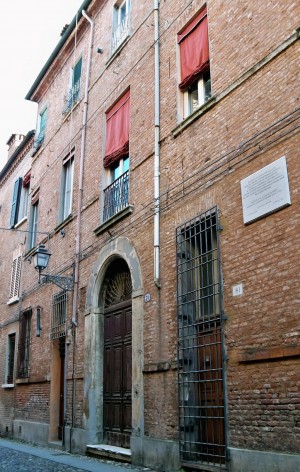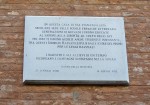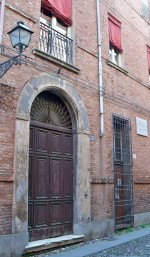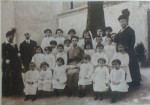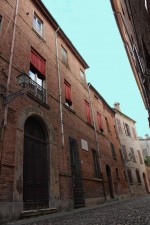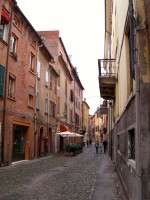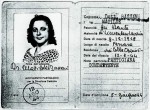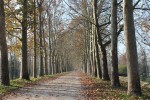The Jewish School in Via Vignatagliata
The school in Via Vignatagliata has served as both a kindergarten and elementary school for the Jewish community in Ferrara since the mid-nineteenth century. From 1939 to 1943, following the enactment of racial laws, it also became the location for middle school, gymnasium, and high school for students expelled from city institutions.
1. The school
Seventy Jewish children were banned from the public schools of Ferrara in autumn of 1938, after the issuing of ‘measures to protect the [Italian] race in Fascist schools’, which prohibited Jewish teachers and Jewish students from enrolling or teaching at any type or grade of school. As of the 1938-39 academic year, four professors and two teachers were blocked from teaching at local institutions in Ferrara, while two secondary school headmasters, Emilio Teglio and Joseph Colombo, were relieved of their duties.
The community immediately tried to create a place that would give the children a sense of continuity in their lives (at least in part), in addition to continuing their education. By the 1938-1939 academic year, the rooms in Via Vignatagliata ceded by the Community nursery school were used for group lessons, allowing students in lower middle school classes to keep studying and take their final exams at the end of the year, as required by law.
However, the middle school in Via Vignatagliata was officially opened only in the 1941-42 academic year, after a long bureaucratic procedure. Local authorities thus hoped to have greater control over its activities. On 5 October 1941, regular classes for years 1-3 of middle school began to be held.
The Fascist government of course tried to interfere: in May 1942, the weekly schedule was changed to reflect that of public schools, and both students and teachers were required to go to school on Saturday, contrasting with Jewish traditions and observances, while in October of the same year, the start of school was delayed as the teachers were called up for forced labour. Classes were suspended once again in 1943 when some of the teachers were arrested, including Giorgio Bassani, Matilde Bassani and Primo Lampronti. Classes for the 1943-44 academic year didn’t so much as begin: in November, the President of the community, Felice Bassani, notified the superintendent that, following the drastic displacement of students and teachers, the school would not reopen. The word displacement, of course, was a euphemism for ‘deportation’.
2. The Teachers
Teachers at the school were graduates or undergraduates barred from attending university, like Giorgio Bassani and Matilde Bassani, or professors banned from public schools, like professor Veneziani, the brother of the Choir Director at La Scala, fired in 1938. Chief Rabbi Leone Leoni taught religion, while boxer Primo Lampronti, an Italian champion who had his title revoked, taught gym. It is thanks to these exceptional teachers that the expulsion of Jews from public institutions was turned into an opportunity to explore topics and delve into arguments that would have been nearly impossible in Fascist schools.
3. Quotes
Roseda Tumiati
‘‘Where’s Debenedetti?’ I asked around, stunned, looking at the other rows. ‘And the Levi girl with the fringe and silk stockings?’ How could it be? We've been in the same class for seven years, since the first grade. ‘They aren’t here because they're Jews’, repeated Raffaele, adding: ‘Il Duce said they can’t come to school with us, that we have to stay far away from them because they're impure!’ Debenedetti and Levi? Impure?! ‘They’re impure and they threaten world peace with their riches’. Riches? But Debenedetti's dad is a railway worker and Levi's dad has a toy workshop in an ugly, narrow road...’
Matilde Bassani
‘Giorgio Bassani, Morpurgo and I worked as teachers at the Jewish School in Ferrara. We tried to bring a sense of dignity to the persecuted children, to erase the paralysing idea of uselessness from their fears, to help them understand that their expulsion from society wasn’t personal, but one of the many injustices imposed by a government born of injustice and violence.’
Paolo Ravenna
‘We were distanced from ‘official’ Italy and we became part of another dimension, which we were entirely unprepared for: a country that we didn't know, that we gradually discovered in values that were new to us, like freedom and anti-fascism. It was a slow, complex discovery, but it helped us feel less isolated, to dream of getting out of our mental seclusion... A new spirit developed in Via Vignatagliata, one that would shape our future.’
4. In literature
Giorgio Bassani provides a literary testimony to the alienation of Jews from the Municipal Library following the promulgation of racial laws and the Israelite middle school on Via Vignatagliata in the story "Gli ultimi giorni di Clelia Trotti," the penultimate of the "Cinque storie ferraresi" ("Five Ferrarese Stories"). In the following passage, the autobiographical foundation behind the character Bruno Lattes is evident.
"[...] But young Mr. Bruno Lattes was not in the same situation. Although, as a Jew, he could no longer frequent the Municipal Library, he was already teaching at the Israelite middle school on Via Vignatagliata, and therefore could now consider himself a professor."
(G. Bassani, "Gli ultimi giorni di Clelia Trotti," in "Cinque storie ferraresi," in "Opere, Il romanzo di Ferrara," Mondadori, Milan 2001, p. 145)
Sitography
- resistenzamappe.it/ferrara-fe_persecuzioni-scuola_ebraica.all
Fototeca
Related places
Related Subjects
Related Itineraries
Compiling entity
- Istituto di Storia Contemporanea di Ferrara
- Assessorato alla Cultura e al Turismo, Comune di Ferrara
Author
- Federica Pezzoli
- Sharon Reichel
- Barbara Pizzo

